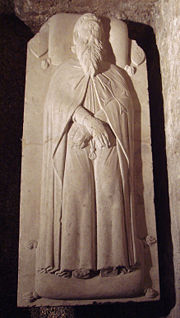
Pierre de Corneillan
Encyclopedia

Rhodes
Rhodes is an island in Greece, located in the eastern Aegean Sea. It is the largest of the Dodecanese islands in terms of both land area and population, with a population of 117,007, and also the island group's historical capital. Administratively the island forms a separate municipality within...
, from 1353 to 1355. His Blazon
Blazon
In heraldry and heraldic vexillology, a blazon is a formal description of a coat of arms, flag or similar emblem, from which the reader can reconstruct the appropriate image...
was : "Gules on a bend argent three Cornish choughs sable"
De Corneillan spent most of his brief rule (18 months) successfully resisting the intentions of Pope Innocent VI
Pope Innocent VI
Pope Innocent VI , born Étienne Aubert; his father was Adhemar Aubert seigneur de Montel-De-Gelas in Limousin province. His niece was Catherine Aubert, Dame de Boutheon, also the wife of Randon II baron de Joyeuse; she is La Fayette's ancestor...
, who planned to move the seat of the Order from Rhodes
Rhodes
Rhodes is an island in Greece, located in the eastern Aegean Sea. It is the largest of the Dodecanese islands in terms of both land area and population, with a population of 117,007, and also the island group's historical capital. Administratively the island forms a separate municipality within...
, to somewhere even closer to Palestine
Palestine
Palestine is a conventional name, among others, used to describe the geographic region between the Mediterranean Sea and the Jordan River, and various adjoining lands....
and the Mamluk
Mamluk
A Mamluk was a soldier of slave origin, who were predominantly Cumans/Kipchaks The "mamluk phenomenon", as David Ayalon dubbed the creation of the specific warrior...
possessions. His marble sarcophagus
Sarcophagus
A sarcophagus is a funeral receptacle for a corpse, most commonly carved or cut from stone. The word "sarcophagus" comes from the Greek σαρξ sarx meaning "flesh", and φαγειν phagein meaning "to eat", hence sarkophagus means "flesh-eating"; from the phrase lithos sarkophagos...
is preserved at the main hall of the Archaeological Museum of Rhodes.

